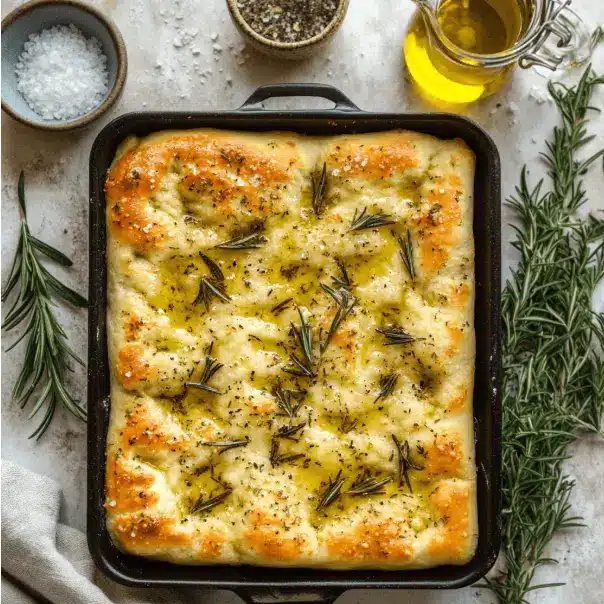Simple Sourdough Focaccia Bread isn’t just a recipe—it’s a slice of comfort baked with love. At Dish RCP, we believe every great meal begins with a story, and this one starts in our test kitchen on a quiet Sunday, filled with flour, trial, and memory.
Our founder, Lila Monroe, was craving the golden, pillowy focaccia her grandmother used to bake—crispy on the outside, soft on the inside. But this time, she wanted to capture that nostalgic flavor with a modern twist: the unique tang and texture of sourdough focaccia bread.
Armed with her bubbly sourdough starter, she combined the basics—bread flour, filtered water, sea salt, and olive oil—crafting the first version of what would become our most-loved simple sourdough focaccia bread recipe. After a few tweaks and plenty of test batches, it turned into the perfect blend of rustic and refined: crispy crust, airy crumb, and an unmistakable sourdough bite.
Here at Dish RCP, our goal is to help home bakers make meaningful recipes with ease. This focaccia recipe is for anyone who wants that artisan bakery experience without the intimidation. Whether you’re working with an active starter or sourdough discard, you’ll learn how to master this easy, flavorful sourdough focaccia bread with confidence.
Get ready to dimple, drizzle, and bake your way to the best simple sourdough focaccia bread you’ve ever tasted—topped with rosemary, kissed by olive oil, and packed with flavor.
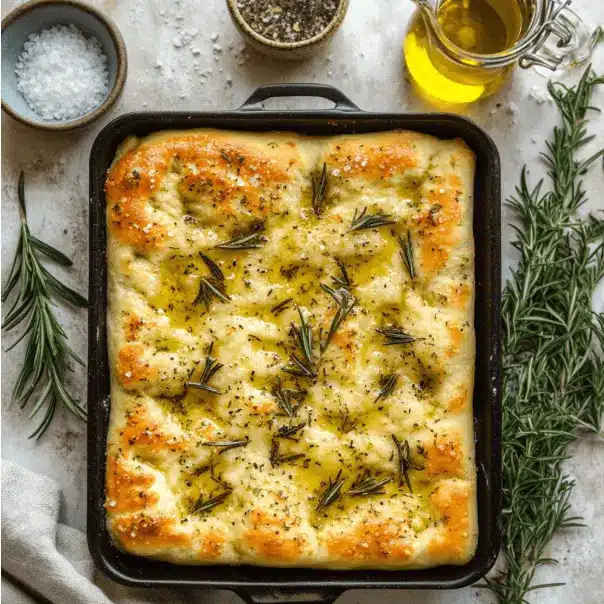
Table of Contents
Table of Contents
What Is Simple Sourdough Focaccia Bread?
The Story and Simplicity Behind Simple Sourdough Focaccia Bread
Simple Sourdough Focaccia Bread is a rustic, Italian-style flatbread made with a sourdough starter instead of commercial yeast. This naturally fermented bread delivers a soft, airy interior, a crackly golden crust, and deep, complex flavor—all without the need for complicated techniques.
At Dish RCP, this recipe started with a craving for something nostalgic, hearty, and homemade. We wanted the rich flavor of sourdough with the easy, hands-off method of focaccia. The result? A reliable and forgiving bread that anyone can master at home.
The beauty of simple sourdough focaccia bread lies in its flexibility. It’s great for meal prep, weekend baking, or whenever your sourdough starter is bubbly and ready. Whether you’re baking it the same day or letting it rise overnight for more tang, this bread fits into your life, not the other way around.
Why You’ll Love This Style of Bread
Choosing simple sourdough focaccia bread over the yeast-based version has real benefits:
- Naturally leavened with no commercial yeast
- Tangier, richer taste thanks to long fermentation
- Better shelf life and easier digestion
- No kneading or scoring—perfect for beginners
- Versatile as a side, sandwich base, or standalone snack
It’s not just about baking bread. It’s about slowing down, working with your hands, and savoring a process that’s as satisfying as the result.
Print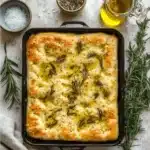
Simple Sourdough Focaccia Bread
- Total Time: 1 hour
- Yield: 1 (9×13-inch) focaccia, serves 8–10
Description
This easy sourdough focaccia recipe comes together with minimal effort—just a little patience goes a long way. But trust us, the wait is worth it for the soft, golden, flavor-packed bread that’s sure to become a favorite!
Ingredients
For the dough
- 100 g Sourdough starter active and bubbly
- 400 g Water can increase or decrease by 30g if desired
- 500 g Bread Flour
- 10 g Salt
For the topping
- 30 g Olive Oil
- 10 g Sea Salt
- 1 tablespoon Rosemary Leaves Fresh or dried
Instructions
How to Make Simple Sourdough Focaccia Bread From Scratch
Mixing the Dough the Right Way
Making Simple Sourdough Focaccia Bread starts with a simple process that transforms basic ingredients into a high-hydration, artisan-style dough.
Start by placing 100g of active sourdough starter and 400g of water into a large mixing bowl. Stir them together to dissolve the starter. Then, add 500g of bread flour and 10g of salt, mixing until no dry flour remains. Don’t overthink it—the dough will be sticky and shaggy, which is exactly what you want at this stage.
This initial mix is all about hydrating the flour and starting gluten development. You can use a Danish dough whisk or your hands, but remember: the goal is cohesion, not perfection.
Once combined, cover the bowl with a damp towel or plastic wrap and let the dough rest at room temperature for 1 hour. This resting period is called autolyse, and it allows the flour to fully absorb water, making the dough easier to work with.
Tools You’ll Want on Hand
To simplify the process, gather these tools before you begin:
- Mixing bowl (preferably large and wide)
- Digital kitchen scale for accurate measurements
- Dough scraper or Danish whisk
- Olive oil for handling sticky dough
- A covered container for fermentation
Making simple sourdough focaccia bread doesn’t require anything fancy—just patience and basic kitchen gear.
Notes
What kind of pan should you use?
Sourdough focaccia is super flexible when it comes to baking vessels. Here are a few great options:
Cast iron skillet or bread pan – I use a 39cm x 26cm (15 x 10 inch) skillet and it works beautifully.
Round cake tins – Split the dough into two portions and bake in 20cm (8 inch) round tins lined with parchment paper.
Standard baking tray – Any medium-sized tray will do. Just grease it well with olive oil or line it with baking paper. The dough will easily stretch to fit the shape.
A quick note on hydration:
This dough is intentionally wet—it helps create that soft, airy texture. As you stretch and fold, the dough will get stronger.
If you’re new to high-hydration doughs, feel free to reduce the water slightly the first time around. You can always add more water next time, but you can’t take it out once it’s in!
- Prep Time: 30 mins
- Cook Time: 30 mins
- Category: Baking, Side Dish, Sides
- Cuisine: American
Nutrition
- Serving Size: 1 Loaf
- Calories: 2345 kcal
- Sodium: 7784mg
- Fat: 59g
- Saturated Fat: 8g
- Carbohydrates: 383g
- Fiber: 14g
- Protein: 63g
Ingredients for the Perfect Simple Sourdough Focaccia Bread
What You’ll Need for the Dough
To make simple sourdough focaccia bread, you need just a few pantry staples—but every ingredient plays a big role in flavor, texture, and structure.
| Ingredient | Amount |
|---|---|
| Sourdough Starter | 100 g (active & bubbly) |
| Water | 400 g (plus or minus 30 g) |
| Bread Flour | 500 g |
| Salt | 10 g |
This combination gives you a high-hydration dough, which leads to that open crumb, chewy bite, and moist interior that focaccia is known for.
The Power of Great Olive Oil and Flour
The topping begins with quality olive oil—and it’s not optional. The olive oil does more than flavor the bread; it helps form that crispy edge, golden top, and signature focaccia character. Choose cold-pressed, extra virgin olive oil for best results.
Bread flour is essential for gluten development, which creates strength and structure. It allows the dough to trap gas from the fermentation process and rise beautifully in the oven.
Together, these ingredients transform a humble dough into simple sourdough focaccia bread that’s worthy of your table.

How to Make Simple Sourdough Focaccia Bread From Scratch
Mixing the Dough the Right Way
Making Simple Sourdough Focaccia Bread starts with a simple process that transforms basic ingredients into a high-hydration, artisan-style dough.
Start by placing 100g of active sourdough starter and 400g of water into a large mixing bowl. Stir them together to dissolve the starter. Then, add 500g of bread flour and 10g of salt, mixing until no dry flour remains. Don’t overthink it—the dough will be sticky and shaggy, which is exactly what you want at this stage.
This initial mix is all about hydrating the flour and starting gluten development. You can use a Danish dough whisk or your hands, but remember: the goal is cohesion, not perfection.
Once combined, cover the bowl with a damp towel or plastic wrap and let the dough rest at room temperature for 1 hour. This resting period is called autolyse, and it allows the flour to fully absorb water, making the dough easier to work with.
Tools You’ll Want on Hand
To simplify the process, gather these tools before you begin:
- Mixing bowl (preferably large and wide)
- Digital kitchen scale for accurate measurements
- Dough scraper or Danish whisk
- Olive oil for handling sticky dough
- A covered container for fermentation
Making simple sourdough focaccia bread doesn’t require anything fancy—just patience and basic kitchen gear.
The Fermentation Process Explained
Bulk Fermentation: Building Flavor and Structure
Once your dough has rested, it’s time for bulk fermentation. This is where the magic happens. Cover the bowl again and allow the dough to sit at room temperature for 4 to 6 hours, depending on how active your starter is and the temperature of your kitchen.
During this time, the dough will rise and develop both flavor and texture. It doesn’t have to double perfectly—just look for a noticeable increase in volume and some visible bubbles on the surface.
To enhance structure, perform one or two rounds of stretch and folds during bulk fermentation. Wet your hands, gently pull one edge of the dough upward, and fold it over itself. Rotate the bowl and repeat 3–4 times. This strengthens the gluten and encourages a more open crumb.
This step is key to achieving that chewy, airy interior that defines well-fermented sourdough focaccia bread.
Cold Fermentation (Optional for Better Flavor)
Want to deepen the flavor? Pop your dough into the fridge after the initial rise for an overnight cold ferment. This slow fermentation enhances sourness, improves crust color, and gives you more flexibility with your baking schedule.
Just make sure to bring the dough back to room temperature before shaping it into your baking pan.
Whether you go with same-day or overnight proofing, the beauty of simple sourdough focaccia bread is how forgiving it is. Either path will yield a crusty, golden flatbread full of complex flavor.
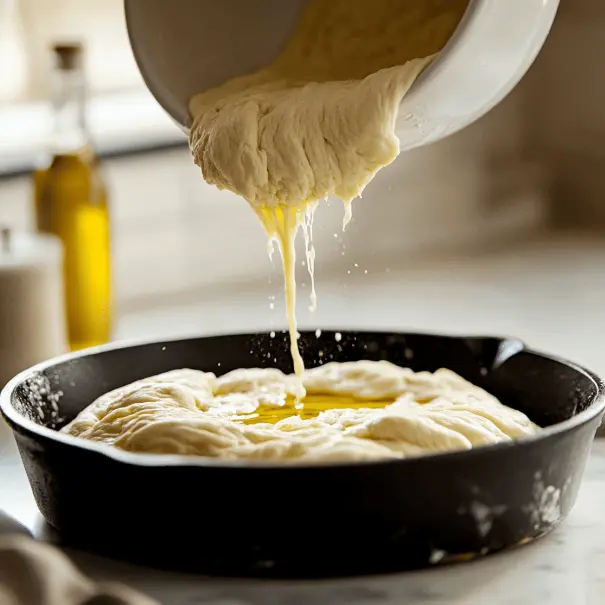
How to Handle the Dough Like a Pro
Strengthening Your Simple Sourdough Focaccia Dough
After your dough finishes autolysing, it’s time to give it structure. This step isn’t about kneading—simple sourdough focaccia bread is all about minimal effort with maximum payoff.
With wet hands, reach around the inside edge of the bowl, gently stretching the dough upward and folding it over itself into the center. Rotate the bowl and repeat this stretch-and-fold technique about 10 to 15 times. Each fold develops the gluten, making the dough stronger and more elastic without overworking it.
This gentle method supports the open, airy structure typical of a great fermented focaccia dough. You’ll notice the dough begin to smooth out slightly and hold its shape better as you go.
Shaping the Dough for the Pan
Once your sourdough focaccia dough has completed its bulk fermentation and nearly doubled in size, it’s time to transfer it to your baking vessel.
Prepare your pan by coating it generously with olive oil. A cast iron skillet, metal baking pan, or even a glass dish can work—just be sure it’s non-stick and roomy enough for the dough to spread. Gently release the dough from the bowl using a dough scraper or oiled hands.
Set the dough into the oiled pan and, with fingers coated in olive oil, gently pull and stretch it to fill the base. Don’t worry if it doesn’t reach all the corners—it will naturally spread during the final rise.
Baking the Sourdough Focaccia
Final Proof and Adding Your Toppings
Before baking your simple sourdough focaccia bread, allow it to proof again. This second rise is crucial—it lets the dough relax into the pan and puff up, developing that pillowy, bubbly texture you’re aiming for.
Once it has visibly filled the tray and looks soft and airy, it’s ready for topping. Pour 30 grams of olive oil over the surface and use your fingertips to press deep dimples into the dough. This not only creates those signature craters but also helps trap the oil, enhancing the flavor and texture.
Now sprinkle with:
- 10 grams of flaky sea salt
- Fresh rosemary leaves (or dried, if preferred)
This topping combo turns a basic loaf into a bakery-style olive oil focaccia that’s bursting with aroma and flavor.
How to Bake Simple Sourdough Focaccia Bread to Golden Perfection
Preheat your oven to 200°C (392°F). Once the dough is dimply, oiled, and topped, place the pan on the middle rack and bake for about 30 minutes.
Watch for a deep golden color on top and crisp edges—a sign your artisan focaccia is ready. When done, remove from the oven and let it rest in the pan for at least 10 minutes before slicing. This helps set the crumb and keeps it moist.
Your simple sourdough focaccia bread is now ready to serve—crackly, fluffy, and full of that unmistakable homemade touch.
Sourdough Focaccia Variations and Toppings
Classic Herb and Sea Salt Topping
The traditional sourdough focaccia topping is simple yet magical:
- Olive oil
- Sea salt flakes
- Fresh rosemary
It complements the tangy sourdough and provides irresistible flavor.
Creative Toppings: Veggies, Cheese, and More
Try experimenting with:
- Cherry tomatoes, garlic, red onion
- Black olives, feta, and oregano
- Parmesan and crushed chili
- Caramelized onion and thyme
Each topping combo gives a new twist to your sourdough focaccia recipe.
Storage, Freezing, and Reheating Tips
How to Store Freshly Baked Focaccia
Store at room temperature in a paper bag or wrapped in parchment for up to 2 days. Avoid plastic—it traps moisture and ruins the crust.
For longer storage:
- Wrap in foil and refrigerate for 3–4 days.
- Freeze slices in airtight bags for up to 1 month.
Reheating Without Losing Texture
To get that fresh-baked feel:
- Toast in a skillet or oven at 180°C (356°F) for 5–7 minutes
- Avoid the microwave—it makes it soggy
Troubleshooting Common Sourdough Focaccia Issues
Why It’s Not Fluffy and How to Fix It
Flat or dense focaccia? Here’s why:
- Starter was weak or inactive
- Underproofed or overproofed
- Not enough hydration
- Improper dimpling or oven temperature
Fix by strengthening your starter and adjusting proofing time.
Dealing with Overproofing or Dense Texture
If the dough collapses or feels gummy:
- You likely overproofed. Shorten the second rise.
- Bake immediately after dimpling.
- Chill the dough if needed to slow fermentation.
For more recipes follow me in pinterest
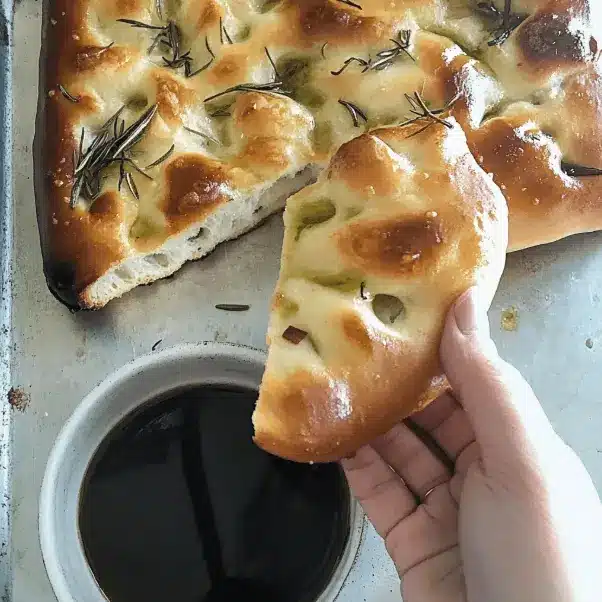
Conclusion: Bring Simple Sourdough Focaccia Bread to Your Table Today
There’s something magical about pulling a warm, golden tray of simple sourdough focaccia bread from your oven. The crisp, olive-oil-soaked crust, the pillowy interior, and the fragrant burst of rosemary make this a bread that’s not only easy to love—but easy to make.
What started with a few ingredients and a bubbly sourdough starter turns into a truly satisfying bake that anyone can achieve. Whether you’re baking for a cozy dinner, a weekend lunch board, or just because your starter is ready, this simple sourdough focaccia bread delivers on flavor, texture, and simplicity.
From mixing and fermenting to dimpling and baking, every step in this focaccia recipe has been designed for success—even if you’re new to sourdough baking. And the best part? Once you master the basics, you can experiment with toppings, flours, and fermentation times to make it your own.
So go ahead—grab your starter, prep your tray, and experience the joy of baking this Italian-inspired classic at home. Once you taste that first piece, golden and warm from the pan, you’ll see why simple sourdough focaccia bread deserves a permanent spot in your baking rotation.
FAQ Section
How do you make sourdough focaccia from scratch?
Mix active starter, water, flour, and salt. Let rest, strengthen the dough, ferment until doubled, shape, proof in pan, dimple, add toppings, and bake.
Can I use sourdough starter straight from the fridge for focaccia?
No. Your starter should be active and bubbly. Feed it and wait until it doubles before using.
How long should you ferment sourdough focaccia?
Bulk fermentation takes 4–6 hours at room temp. You can also cold ferment overnight for better flavor.
Why is my sourdough focaccia not fluffy?
It could be underproofed, overproofed, or your starter wasn’t strong enough.
Can I use olive oil in sourdough focaccia?
Yes! Olive oil adds flavor, creates a crispy crust, and prevents sticking in the pan.
What toppings go well with sourdough focaccia?
Try rosemary, cherry tomatoes, red onions, olives, cheese, and garlic for endless flavor variations.

